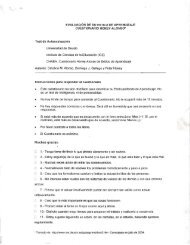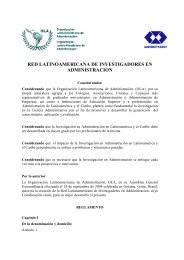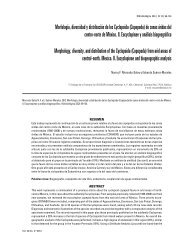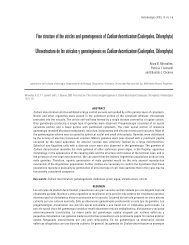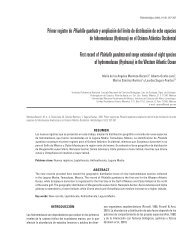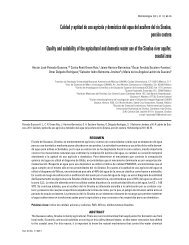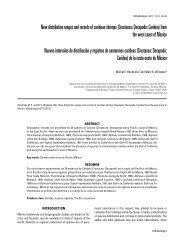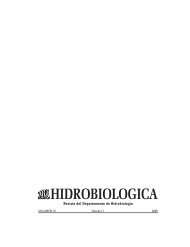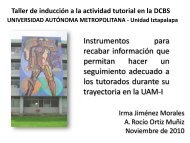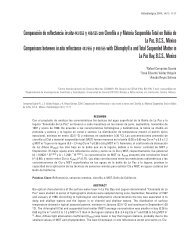Notes on some alpheid shrimps (Decapoda: Caridea) of Thalassia ...
Notes on some alpheid shrimps (Decapoda: Caridea) of Thalassia ...
Notes on some alpheid shrimps (Decapoda: Caridea) of Thalassia ...
You also want an ePaper? Increase the reach of your titles
YUMPU automatically turns print PDFs into web optimized ePapers that Google loves.
224 Román-C<strong>on</strong>treras and Martínez-Mayén<br />
Superfamily Alpheoidea Rafinesque, 1815<br />
Family Alpheidae Rafinesque, 1815<br />
Alpheus cf. armillatus H. Milne-Edwards, 1837<br />
Alpheus armillatus. Chace, 1972: 62; Felder & Chaney, 1979:<br />
25; Markham & McDermott, 1980: 1270; Rodríguez, 1980: 142, fig.<br />
40 h-k; Williams, 1984: 92, fig. 63; Martínez-Iglesias, 1986: 8, fig.<br />
3C; Markham et al., 1990: 420; Martínez-Guzmán & Hernández-<br />
Aguilera, 1993: 614; Hernández Aguilera et al., 1996: 28; Martínez-<br />
Iglesias et al., 1997: 403, fig. 4; Christ<strong>of</strong>fersen, 1998: 356; Bri<strong>on</strong>es-<br />
Fourzán & Lozano-Álvarez, 2002: 200; McClure, 2005: 129, fig. 6;<br />
Mossolin et al., 2006: 48.<br />
Alpheus cf. armillatus. Almeida et al., 2007: 11.<br />
Crang<strong>on</strong> armillatus. Schmitt, 1935: 142.<br />
Material examined: Bahía del Espíritu Santo, 2 specimens,<br />
November 2001.<br />
Distributi<strong>on</strong>: North Carolina (Williams, 1984) to nearby Port<br />
Aransas, Texas (Felder & Chaney, 1979); from Isla Lobos, Veracruz<br />
(Hernández Aguilera et al., 1996) and Isla Pérez, Arrecife Alacrán,<br />
Yucatán, Gulf <strong>of</strong> Mexico (Martínez-Guzmán & Hernández-Aguilera,<br />
1993), Isla Cozumel, Quintana Roo (Chace, 1972; Bri<strong>on</strong>es-<br />
Fourzán & Lozano-Álvarez, 2002), south to Santa Catarina, Brazil<br />
(Christ<strong>of</strong>fersen, 1998); West Indies from Bermuda (Markham &<br />
McDermott, 1980) to Tobago (Chace, 1972).<br />
Ecological notes: Under rocks and shells between interstices<br />
<strong>of</strong> coral (Chace, 1972); in sp<strong>on</strong>ges (Markham et al., 1990),<br />
and turtle-grass (McClure, 2005). Shallow-water to 14 m (Felder &<br />
Chaney, 1979), <strong>on</strong> calcareous bottom covered with T. testudinum,<br />
depth 0.5 m (present study).<br />
Local new records: Bahía del Espíritu Santo, Quintana Roo.<br />
Remarks: The material examined fits well with Chace’s (1972)<br />
key, and the figures and keys presented by Martínez-Iglesias et<br />
al. (1997) and McClure (2005) for the species. Alpheus armillatus<br />
is a large species complex that includes many cryptic species<br />
(Mathews & Anker, 2009). Those authors, based <strong>on</strong> molecular<br />
analyses <strong>of</strong> this species complex from the Caribbean Sea, Gulf <strong>of</strong><br />
Mexico, Florida, Brazil, and the tropical eastern Pacific, reported<br />
the presence <strong>of</strong> six clades broadly overlapped in their geographic<br />
distributi<strong>on</strong>, including 11 lineages in the western Atlantic and<br />
eight in the eastern Pacific, for a total number <strong>of</strong> at least 19 putative<br />
species c<strong>on</strong>tained in the A. armillatus species complex.<br />
Alpheus bouvieri A. Milne-Edwards, 1878<br />
Alpheus Edwarsii . Dana, 1852: 542 [not Audouin, 1826].<br />
Alpheus bouvieri. Christ<strong>of</strong>fersen, 1979: 303, figs. 2-5; Markham<br />
& McDermott, 1980: 1270; Abele & Kim, 1986: 18, 199, 214-215,<br />
figs. a-d; Markham et al., 1990: 421; Manning & Chace, 1990: 14;<br />
Hernández Aguilera et al., 1996: 30; Martínez-Iglesias et al., 1996:<br />
33; Martínez-Iglesias et al., 1997: 404, fig. 6; McClure, 2005: 133<br />
(part., not Fig. 8; see Anker et al., 2009).<br />
Not A. bouvieri. Christ<strong>of</strong>fersen, 1979: 303 (part., material from<br />
eastern Pacific; see Anker et al., 2009); Kim & Abele, 1988: 58, fig.<br />
24 (see Williams et al., 2001 and Anker et al., 2009).<br />
Material examined: Bahía de la Ascensión, <strong>on</strong>e specimen,<br />
May 2002.<br />
Distributi<strong>on</strong>: Eastern and southern Florida (Abele & Kim,<br />
1986); Gulf <strong>of</strong> Mexico: Veracruz and Campeche (Hernández Aguilera<br />
et al., 1996), Punta Xamach, Bahía de la Ascensión, Quintana<br />
Roo, Mexico (Markham et al., 1990); Bermuda (Markham & Mc-<br />
Dermott, 1980) and Cuba (Martínez-Iglesias et al., 1996) to Trinidad<br />
(Christ<strong>of</strong>fersen, 1979); south to Torres, Rio Grande do Sul, Brazil<br />
(Christ<strong>of</strong>fersen, 1979); eastern Atlantic from Cape Verde Islands<br />
and Senegal to Ilha de Sao Tomé and C<strong>on</strong>go (Christ<strong>of</strong>fersen,<br />
1979); south Atlantic: Ascensi<strong>on</strong> Island (Manning & Chace, 1990).<br />
Ecological notes: Am<strong>on</strong>g rocks, dead coral, <strong>some</strong>times in<br />
sp<strong>on</strong>ges (Christ<strong>of</strong>fersen, 1979), <strong>on</strong> zoanthids and coralline algae<br />
(Anker et al., 2009). Shallow subtidal to about 10 m depth (Anker<br />
et al., 2009), in beds <strong>of</strong> T. testudinum <strong>on</strong> sand, depth 0.6 m (present<br />
study).<br />
Remarks: The specimen examined agrees in general with<br />
Chace’s (1972) key, and the descripti<strong>on</strong> and figures by Christ<strong>of</strong>fersen<br />
(1979) and Anker et al. (2009) for A. bouvieri. This species<br />
was reported previously from the eastern Pacific and the Atlantic<br />
by Kim and Abele (1988). Anker et al. (2009) reviewed the Alpheus<br />
bouvieri species complex and restricted A. bouvieri to the<br />
Atlantic, while the eastern Pacific populati<strong>on</strong>s were assigned to<br />
Alpheus javieri Anker, Hurt and Knowlt<strong>on</strong>, 2009. This species is<br />
genetically distinct and with little differences in morphology and<br />
color pattern respect to A. bouvieri, such as a slightly narrower<br />
and deeper dorsal groove <strong>on</strong> the palm <strong>of</strong> the major chela, and the<br />
slightly shorter first carpal segment <strong>of</strong> the sec<strong>on</strong>d pereiopod, as<br />
well as tan or brown-colored spines <strong>on</strong> the propodus <strong>of</strong> third and<br />
fourth pereiopods, whereas in A. bouvieri such spines do not bear<br />
traces <strong>of</strong> color (Anker et al., 2009).<br />
A recently described species that could be c<strong>on</strong>fused with A.<br />
bouvieri in the western Atlantic is A. agilis Anker, Hurt & Knowlt<strong>on</strong>,<br />
2009, which is distributed <strong>on</strong>ly in Brazil and West Africa, distinguished<br />
from A. bouvieri by the presence <strong>of</strong> a spine <strong>on</strong> ischium<br />
<strong>of</strong> the third and fourth pereiopods (see Anker et al., 2009).<br />
Alpheus cf. floridanus Kingsley, 1878<br />
Alpheus floridanus. Chace, 1972: 65, figs. 17-20 (part.); Herbst<br />
et al., 1978: 991; Christ<strong>of</strong>fersen, 1979: 311, figs. 6-8; Markham &<br />
Hidrobiológica



